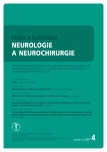Clinical View of the Otorhinolaryngologist and Radiologist on the Classification of Fractures of the Temporal Bone
Authors:
Jana Šatanková 1
; Jana Dědková 2; Viktor Chrobok 1
Authors place of work:
LF UK a FN Hradec Králové
Klinika otorinolaryngologie
LF UK a FN Hradec Králové
a chirurgie hlavy a krku
1; LF UK a FN Hradec Králové
Radiologická klinika
2
Published in the journal:
Cesk Slov Neurol N 2017; 80/113(4): 457-463
Category:
Krátké sdělení
doi:
https://doi.org/10.14735/amcsnn2017457
Summary
Introduction:
Temporal bone fractures are traditionally classified as transverse, longitudinal or mixed (according to the direction of fracture). However, this classification has shown little association with clinical symptoms and later progressive symptomatology, and therefore a new classification system has been introduced based on High-Resolution Computed Tomography. It includes the involvement of all parts of the temporal bone (processus mastoideus, pars squamosa, pars tympanica, pars petrosa) and involvement or sparing of the otic capsule (vestibule, cochlea, semicircular canals).
Methods:
We carried out a retrospective analysis of 89 patients with a fracture of the temporal bone using high-resolution computed tomography scans taken in the period from January 2003 to September 2013. We compared the correlation between the new classification of fractures of the temporal bone and the clinical symptoms.
Results:
Involvement of the petrous bone was associated with a higher incidence of sensorineural hearing loss, especially in patients with fractures affecting the otic capsule. In these cases, we found severe hearing impairments or deafness. The patients with petrous fracture affecting the otic capsule showed a higher incidence of facial palsy. The occurrence of dizziness, tinnitus and perforation of tympanic membrane was higher in petrous fractures, especially when the otic capsule was involved. There were no significant differences between non-petrous and petrous fractures in terms of the occurrence of otorrhoea and hemotympanum.
Conclusion:
The new classification of fractures according to the involvement of individual parts of the temporal bone has a better correlation with clinical symptoms.
Key words:
temporal bone – fracture – otic capsule – petrous bone – high-resolution computed tomography
The authors declare they have no potential conflicts of interest concerning drugs, products, or services used in the study.
The Editorial Board declares that the manuscript met the ICMJE “uniform requirements” for biomedical papers.
Chinese summary - 摘要
耳鼻咽喉科与放射科骨科医师对颞骨骨折分类的临床观察介绍:
传统上将颞骨骨折分为横向、纵向或混合(根据骨折的方向)。然而,这种分类与临床症状和后来的进展性症状没有太大关系,因此一个新的基于高分辨率计算机断层扫描技术的分类系统被引进。它包括颞骨的所有部分(乳突,鳞部,鼓部,岩部)和参与或保留的耳软骨囊(前庭,耳蜗,半规管)。
方法:
我们使用在2003年1月至2013年9月期间通过高分辨率计算机断层扫描技术获取的89例颞骨骨折患者的数据进行一项回顾性分析。我们比较了颞骨骨折新分类与临床症状之间的关系。
结果:
岩骨参与感觉神经性听力损失的发生率较高,特别是影响耳囊的骨折患者。在这些情况下,我们发现严重的听力障碍或耳聋。 影响耳囊的岩部骨折患者发生面瘫的几率较高。 岩部骨折尤其是涉及耳软骨囊时,发生眩晕,耳鸣,鼓膜穿孔的几率较高。非岩部骨折和岩部骨折患者在耳漏和鼓室积血发生率方面没有显着差异。
结论:
根据颞骨各个部位的涉及情况,骨折的新分类与临床症状有较好的相关性。
关键词:
颞骨骨折 - 耳膜 - 岩骨 - 高分辨率计算机断层扫描
Zdroje
1. Čihák R, Grim M, et al. Anatomie I. Praha: Grada Publishing 2001:147– 54.
2. Wood CP, Hunt CH, Bergen DC, et al. Tympanic plate fractures in temporal bone trauma: Prevalence and associated injuries. AJNR AM J Neuroradiol 2014;35(1);186– 90. doi: 10.3174/ ajnr.A3609.
3. Kovaľ J, Hajtman A, Hroboň M, et al. Nervus Facialis. Bratislava: Remar s.r.o. 2002:11– 3,20– 1.
4. Ishman SL, Friedland DR. Temporal bone fractures: traditional classification and clinical relevance. Laryngoscope 2004;114(10);1734– 41.
5. Kang HM, Kim MG, Boo SH, et al. Comparison of the clinical relevance of traditional and new classification systems of temporal bone fractures. Eur Arch Otorhinolaryngol 2012;269(8):1893– 9. doi: 10.1007/ s00405-011-1849-7.
6. Bacciu A, Vincenti V, Prasad SC, et al. Pneumolabyrinth secondary to temporal bone fracture: a case report and review of the literature. Int Med Case Rep J 2014;7:127– 31. doi: 10.2147/ IMCRJ.S66421.
7. Park SY, Yang JW, Kim SI, et al. Clinical study on the reliable temporal bone fracture classification scheme. Korean J Otolaryngol 2007;50:491– 5.
8. Rajati M, Rad M, Irani S, et al. Accuracy of high-resolution computed tomography in locating facial nerve injury sites in temporal bone trauma. Eur Arch Otorhinolaryngol 2014;271(8):2185– 9. doi: 10.1007/ s00405-013-2709-4.
9. Skoloudik L, Vokurka J, Simakova E. Mechanical treatment and autoclaving of middle ear ossicles from cholesteatomatous ears. Cent Eur J Med 2012;7:194– 19. doi: 10.2478/ s11536-011-0140-z.
10. Skoloudik L, Kalfert D, Zborayova K, et al. Autoclaving of the middle ear ossicles in an animal experimental model. Acta Otolaryngol 2013;133(12):1273– 7. doi: 10.3109/ 00016489.2013.825378.
11. Lim JH, Jun BC, Song SW. Clinical Feasibility of Mul-tiplanar Reconstruction Images of Temporal Bone CTin the diagnosis of temporal bone fracture with otic – capsule – sparing facial nerve paralysis. Indian J Otolaryngol Head Neck Surg 2013;65(3):219– 24. doi: 10.1007/ s12070-011-0471-8.
12. Collins JM, Krishnamoorthy AK, Wayne SK, et al. Multidetector CT of temporal bone fractures. Semin Ultrasound CT MR 2012;33(5):418– 31. doi: 10.1053/ j.sult.2012. 06.006.
13. Zayas JO, Feliciano YZ, Hadley CR, et al. Temporal bone trauma and the role of multidetector CT in the emergency department. Radiographics 2011;31(6):1741– 55. doi: 10.1148/ rg.316115506.
14. Hahn A, Čoček A, et al. Otorinolaryngologie a foniatrie v současné praxi. Praha: Grada Publishing 2007:49.
15. Little SC, Kesser BW. Radiographic classification of temporal bone fractures: clinical predictability using a new system. Arch Otolaryngol Head Neck Surg 2006;132(12):1300– 4.
16. Rafferty MA, Walsh R, Walsh MA. A comparison of temporal bone fracture classification systems. Clin Otolaryngol 2006;31(4):287– 91.
17. Stewart C, Little MD, Bradley W et al. Radiographic classification of temporal bone fractures: clinical predictability using a new system. Arch Otolaryngol Head Neck Surg 2006;132(12):1300– 4.
18. Brodie HA, Thomson TC. Management of complications from 820 temporal bone fractures. Am J Otol 1997;18(2):188– 97.
19. Dahiya R, Keller JD, Litofsky NS, et al. Temporal bone fractures: Otic capsule sparing versus otic capsule violating clinical and radiographic considerations. J Trauma 1999;47(6):1079– 83.
Štítky
Dětská neurologie Neurochirurgie NeurologieČlánek vyšel v časopise
Česká a slovenská neurologie a neurochirurgie

2017 Číslo 4
- Metamizol jako analgetikum první volby: kdy, pro koho, jak a proč?
- MUDr. Lenka Klimešová: Multioborová vizita může být klíčem k efektivnější perioperační léčbě chronické bolesti
- Nejčastější nežádoucí účinky venlafaxinu během terapie odeznívají
Nejčtenější v tomto čísle
- Český národní registr Guillainova-Barrého syndromu
- Klinický pohled otorinolaryngologa a radiologa na klasifikaci zlomenin spánkové kosti
- Doporučený postup České pneumologické a ftizeologické společnosti a České společnosti dětské pneumologie pro dlouhodobou domácí léčbu poruch expektorace pomocí přístroje CoughAssist
- Poranění periferních nervů při suprakondylických zlomeninách humeru u dětí
